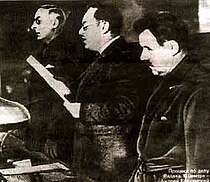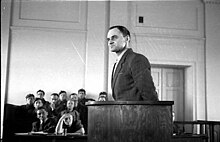
Klement Gottwald was a Czech communist politician, who was the leader of the Communist Party of Czechoslovakia from 1929 until his death in 1953 – titled as general secretary until 1945 and as chairman from 1945 to 1953. He was the first leader of Communist Czechoslovakia from 1948 to 1953.

The State Protection Authority was the secret police of the People's Republic of Hungary from 1945 to 1956. The ÁVH was conceived as an external appendage of the Soviet Union's KGB in Hungary responsible for supporting the ruling Hungarian Working People's Party and persecuting political criminals. The ÁVH gained a reputation for brutality during a series of purges but was gradually reined in under the government of Imre Nagy, a moderate reformer, after he was appointed Prime Minister of Hungary in 1953. The ÁVH was dissolved by Nagy's revolutionary government during the Hungarian Revolution of 1956 and succeeded by the Ministry of Internal Affairs III.
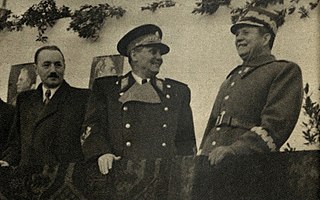
Titoism is a socialist political philosophy most closely associated with Josip Broz Tito during the Cold War. It is characterized by a broad Yugoslav identity, socialist workers' self-management, a political separation from the Soviet Union, and leadership in the Non-Aligned Movement.

The Slánský trial was a 1952 antisemitic show trial against fourteen members of the Communist Party of Czechoslovakia (KSČ), including many high-ranking officials. Several charges, including high treason, were announced against the group on the grounds of allegedly conspiring against the Czechoslovak Republic. General Secretary of the KSČ Rudolf Slánský was the alleged leader of the conspirators.

János József Kádár, born János József Czermanik, was a Hungarian Communist leader and the General Secretary of the Hungarian Socialist Workers' Party, a position he held for 32 years. Declining health led to his retirement in 1988, and he died in 1989 after being hospitalized for pneumonia.

Rudolf Slánský was a leading Czech Communist politician. Holding the post of the party's General Secretary after World War II, he was one of the leading creators and organizers of Communist rule in Czechoslovakia.

László Rajk was a Hungarian Communist politician, who served as Minister of Interior and Minister of Foreign Affairs. He was an important organizer of the Hungarian Communists' power, but he eventually fell victim to Mátyás Rákosi's show trials.
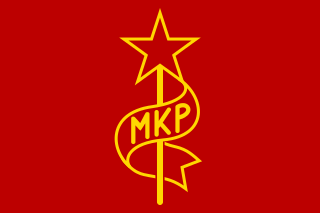
The Hungarian Communist Party, known earlier as the Party of Communists in Hungary, was a communist party in Hungary that existed during the interwar period and briefly after World War II.

General Heliodor Píka was a Czechoslovak army officer who was the first Victim of judicial murder of the Czechoslovak Communist show trials.

The Czechoslovak Socialist Republic, known from 1948 to 1960 as the Czechoslovak Republic, Fourth Czechoslovak Republic, or simply Czechoslovakia, was the Czechoslovak state from 1948 until 1989, when the country was under communist rule, and was regarded as a satellite state in the Soviet sphere of interest.

Milada Horáková was a Czech politician and a member of the underground resistance movement during World War II. She was a victim of judicial murder, convicted and executed by the Communist Party of Czechoslovakia on fabricated charges of conspiracy and treason. Many prominent figures in the West, including Albert Einstein, Vincent Auriol, Eleanor Roosevelt and Winston Churchill, petitioned for her life.

Capital punishment is forbidden by the Charter of Fundamental Rights and Freedoms of the Czech Republic and is simultaneously prohibited by international legal obligations arising from the Czech Republic's membership of both the Council of Europe and the European Union.

The Hungarian People's Republic was a one-party socialist state from 20 August 1949 to 23 October 1989. It was governed by the Hungarian Socialist Workers' Party, which was under the influence of the Soviet Union. Pursuant to the 1944 Moscow Conference, Winston Churchill and Joseph Stalin had agreed that after the war Hungary was to be included in the Soviet sphere of influence. The HPR remained in existence until 1989, when opposition forces brought the end of communism in Hungary.

Pankrác Prison, officially Prague Pankrác Remand Prison in Czech), is a prison in Prague, Czech Republic. A part of the Czech Prison Service, it is located southeast of Prague city centre in Pankrác, not far from Pražského povstání metro station on Line C. It is used in part for persons awaiting trial and partly for convicted prisoners. Since 2008, women have also been incarcerated here.

Rudolf Margolius was a Czech lawyer and economist, Deputy Minister for Foreign Trade, Czechoslovakia (1949–1952), and a co-defendant in the Slánský trial in November 1952.
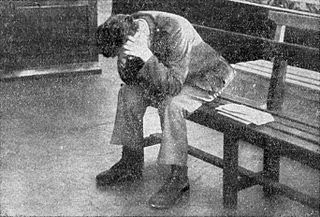
The Trial of Draža Mihailović et al., or the Belgrade Process, was the 1946 trial of Draža Mihailović and a number of other prominent convicted collaborators for high treason and war crimes committed during World War II.
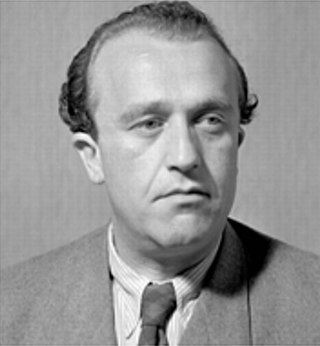
Otto Šling was a Czechoslovak politician. He was born into a Jewish family in Nová Cerekev, a market town in south Bohemia, then part of the Austrian Empire. After World War II, Šling became the Communist Party's Regional Secretary of Brno in Czechoslovakia.
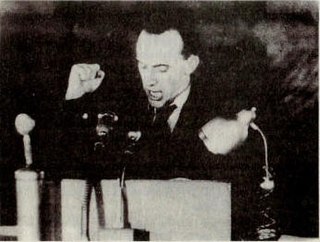
JUDr. Josef Urválek was a procurator and later judge of the Czechoslovak state court. He is known for his participation in the political processes in socialist Czechoslovakia during the 1950s. In a number of show trials, most notably during the Slánský trial, he was responsible for securing the death sentences of Milada Horáková and of 14 communist functionaries, including Rudolf Slánský, on trumped-up charges of treason.

Eastern Bloc politics followed the Red Army's occupation of much of Central and Eastern Europe at the end of World War II and the Soviet Union's installation of Soviet-controlled Marxist–Leninist governments in the region that would be later called the Eastern Bloc through a process of bloc politics and repression. These governments contained apparent elements of representative democracy to conceal the process initially.
Ludmila Brožová-Polednová was a Czech state prosecutor sentenced at age 86 in September 2008 to six years' imprisonment for her participation in the show trials of Milada Horáková and others in 1950, which led to at least four executions.

